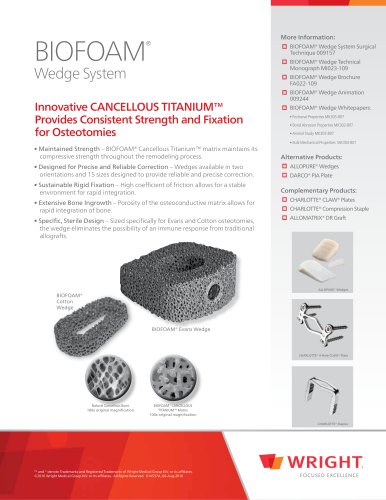
Catalog excerpts

Polyaxial Compression Plating System
Open the catalog to page 1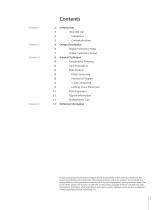
Chapter 2 4 Design Description 4 Implant Selection: Plates 7 Implant Selection: Screws Chapter 3 8 Surgical Technique 9 Locking Screw Placement Proper surgical procedures and techniques are the responsibility of the medical professional. The following guidelines are furnished for information purposes only. Each surgeon must evaluate the appropriateness of the procedures based on his or her personal medical training and experience. Prior to use of the system, the surgeon should refer to the product package insert for complete warnings, precautions, indications, contraindications, and adverse...
Open the catalog to page 5
The CLAW® II Polyaxial Compression Plating System represents the next evolution of Wright’s proprietary CLAW® technology for osteotomies and arthrodeses of the foot. The system incorporates ORTHOLOC® 3DSi Polyaxial Locking Screw Technology into a variety of anatomic-specific stainless steel compression plates, allowing versatile implant solutions for both simple and complex indications of the foot. This new system now provides the foot and ankle surgeon: »» Expanded Offering of 5 Plate Styles, Including the Indication Specific U-Plates Designed for 1st & 2nd TMT Fusions »» Plate Holes...
Open the catalog to page 6
Intended Use Indications Wright’s CLAW® II Polyaxial Compression Plating System is intended to be used for fixation including: »» Midfoot and hindfoot arthrodeses or osteotomies »» Tarsometatarsal arthrodeses (metatarsocuneiform, metatarsocuboid, Lapidus) »» Intercuneiform arthrodeses »» Naviculocuneiform arthrodeses »» Talonavicular arthrodeses »» Calcaneocuboid arthrodeses »» Lisfranc arthrodeses »» Mono-or bi-cortical osteotomies in the forefoot, midfoot and hindfoot »» Fixation of osteotomies for hallux valgus treatment (e.g., Scarf and Chevron) »» Akin osteotomies »» First...
Open the catalog to page 7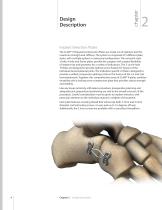
Design Description Implant Selection: Plates The CLAW® II Polyaxial Compression Plates are made out of stainless steel for maximum strength and stiffness. The system is composed of 5 different plate styles, with multiple options in sizing and configuration. The universal-style 2-hole, 4-hole and Series plates provide the surgeon with surgical flexibility of implant size and geometry for a variety of indications. The 3- and 4-hole T-Plates are designed to provide optimal screw fixation for fusions of the individual tarsometatarsal joints. The indication specific U-Plate is designed to...
Open the catalog to page 8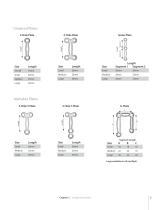
Universal Plates Series Plate Length Segment 1 Segment 2 Alphabet Plates 3-Hole T-Plate Segment Length Large available in Left and Right Design Description
Open the catalog to page 9
Implant Selection: Plates The following tables may assist with implant selection based on the supported indications for the CLAW® II Polyaxial Compression Plating System. Table 1 details the general indication categories, while Table 2 identifies the particular mid- & hind-foot indications for which each plate was designed. FIGURE 1 demonstrates the recommended orientation and placement of the U-Plate for 1st and 2nd TMT fusions. Table 1 - Indications | FIGURE 1 Recommended placement and orientation of U-Plate Styles. Plate Type Plate Design Mono-or-Bi -Cortical Osteotomies of the Forefoot...
Open the catalog to page 10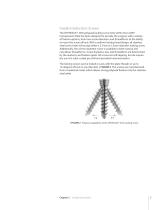
Implant Selection: Screws The ORTHOLOC® 3DSi polyaxial locking screw hole within the CLAW® Compression Plate has been designed to provide the surgeon with a variety of fixation options, from two screw diameters and threadforms to the ability to insert the screw off-axis. With a uniform locking head design, all stainless steel screw holes will accept either a 2.7mm or 3.5mm diameter locking screw. Additionally, the 3.5mm diameter screw is available in both cortical and cancellous threadforms. Screw diameter, size, and threadform are determined by the anatomy and fixation goals. All screws...
Open the catalog to page 11
Surgical Technique Preoperative Planning The CLAW® II Polyaxial Compression Plating System comprises a variety of plating styles and sizes, many designed for a particular indication. Preoperative selection of the appropriate size and style of plate will facilitate a streamlined surgical procedure. Joint Preparation The joints to be fused are prepared by thoroughly debriding the articular surfaces, and manually reducing the anatomy to ensure good bony apposition of the joint surfaces. Provisional fixation of the reduction can be accomplished with a 1.6mm K-wire (P/N 44112008). Plate Fixation...
Open the catalog to page 12
Locking Screw Placement In order to achieve a unified plating construct for compression, every screw hole on the plate must be utilized with an ORTHOLOC® 3DSi locking screw. It is recommended to place the distal locking screws before the proximal screws to facilitate plate positioning and contouring. The CLAW® II Polyaxial Compression Plates’ Locking Screw Holes have been designed to accept both 2.7mm and 3.5mm ORTHOLOC® 3DSi locking screws. All locking screws can be placed on-axis with the internal plate threads or up to 15-degrees off-axis in any direction. When using a locking screw...
Open the catalog to page 13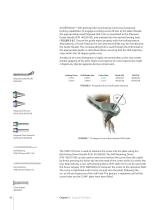
All ORTHOLOC® 3DSi locking holes and locking screws have polyaxial locking capabilities. To engage a locking screw off-axis to the plate threads, the appropriately sized Polyaxial Drill Cone is assembled to the Polyaxial Guide Handle (P/N 40250100), and inserted into the desired locking hole. | FIGURE 6 & 7 Ensure the guide mates properly with the locking feature. Alternatively, a Tissue Protector for the selected Drill Bit may be inserted into the Guide Handle. The corresponding Drill is used through the Drill Guide to the appropriate depth, as described above, ensuring that the drill...
Open the catalog to page 14
Plate Expansion The plate arms are then distracted by using the Plate Spreader (P/N 40250030) to create compression of the joint. The tips of the Spreader are inserted in between the arms of the plate, and firm pressure is applied to the Spreader to expand the arms and achieve compression at the joint. | FIGURE 8 For plates involving multiple spans it is recommended to maintain an order of compression from proximal to distal and then medial to lateral, although the specific order is left to the judgement of the surgeon, and may depend on specific factors such as patient anatomy, surgeon...
Open the catalog to page 15All Wright Medical Technology catalogs and technical brochures
-
Focused on Biologics
2 Pages
-
Wright Code of Business Conduct
36 Pages
-
FORCE FIBER
4 Pages
-
BIOFOAM®
1 Pages
-
TENSIX
2 Pages
-
ALLOPURE
6 Pages
-
MEDIALMAX
2 Pages
-
DARCO™
1 Pages
-
INVISION™
2 Pages
-
PROPHECY
6 Pages
-
SWANSON Flexible Hinge Toe
1 Pages
-
css
4 Pages
-
Hemi Phalangeal Implant
2 Pages
-
EVOLVE PROLINE
2 Pages
-
ALLOMATRIX C Brochure
2 Pages
-
Darco MFS ? SO117?407
8 Pages
-
Darco MRS ? SO118?407
8 Pages









